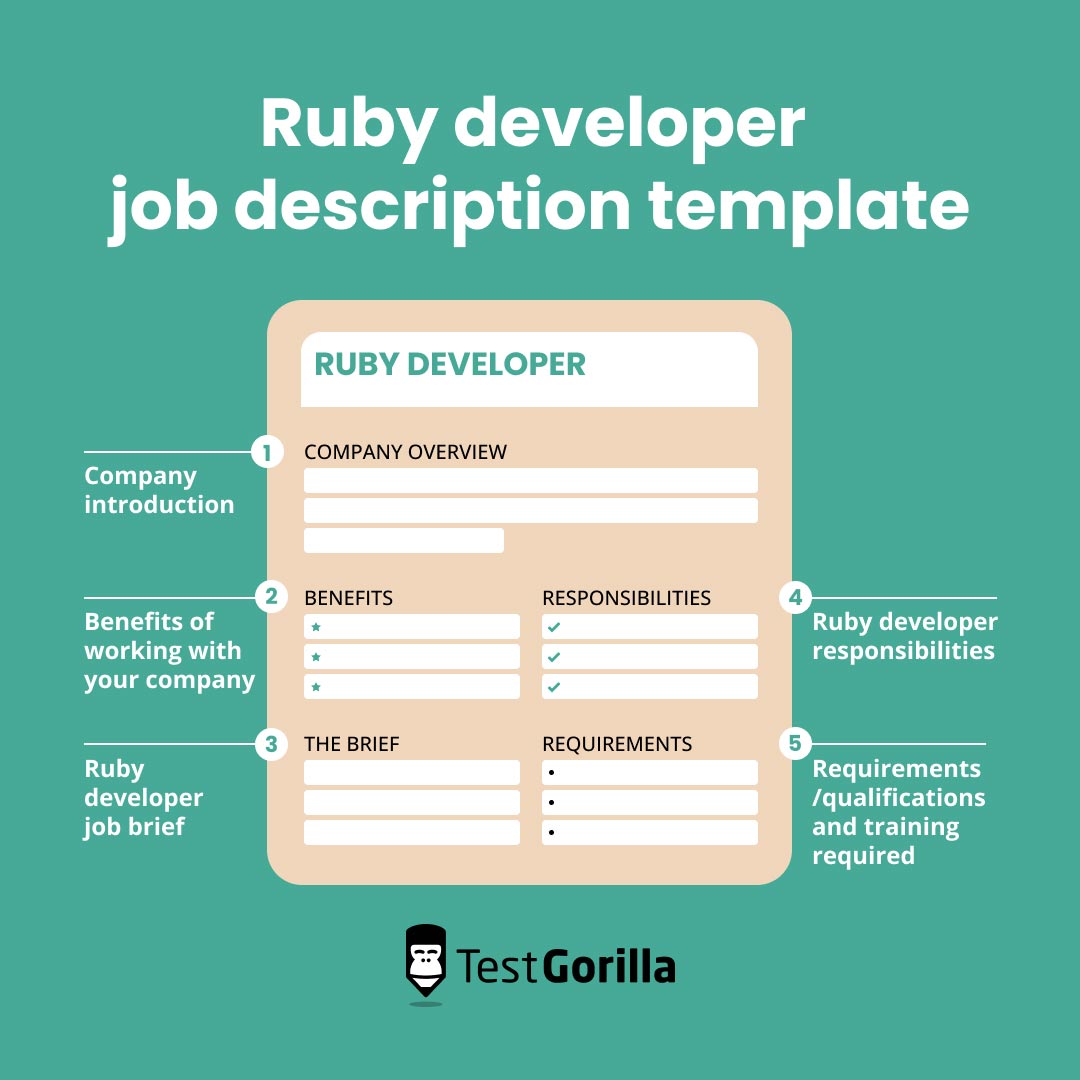Hiring the best Ruby developer is key to ensuring your company’s web apps work smoothly. Without a knowledgeable and skilled developer, you run the risk of downtime and outages that frustrate employees and turn away customers. So it’s crucial to hire a Ruby developer who knows this programming language inside and out.
The process of hiring a Ruby developer starts with writing a great job description. It should clearly describe who you want to hire and why they’d want to work for your company.
In this guide, we’ll explain how to write a compelling Ruby developer job description and share a template you can use to kickstart your hiring process.
Table of contents
- What is a Ruby developer?
- Key skills to look for in Ruby developers
- How to write an effective Ruby developer job description
- Ruby developer job description template
- 2 things to avoid when writing a job description for Ruby developers
- Next steps: Attracting and assessing Ruby developer candidates
- FAQs
- Hire the best Ruby developer with TestGorilla
What is a Ruby developer?
A Ruby developer is a programmer who is highly proficient in the Ruby coding language. Ruby is commonly used for building web apps and static websites, scripting, and automating software processes.
Ruby is also the coding language used for the popular Ruby on Rails web application framework. A Ruby developer can help your company build new web apps using Ruby on Rails or maintain existing apps.
Key skills to look for in Ruby developers
Look for these skills when hiring a Ruby developer:
Ruby proficiency: Candidates should have a deep understanding of and experience using the Ruby programming language.
Ruby on Rails experience: Ruby on Rails is based on Ruby and is used for many web apps, so having a developer with Ruby on Rails experience can expand your business’s capabilities.
HTML and CSS competency: HTML and CSS are used alongside Ruby for many static websites. Competency in these programming languages can help your developer work more efficiently.
Collaboration: The developer you hire should have strong collaboration skills to work smoothly with the rest of your development team and project managers.
Time management: Candidates must be able to manage multiple projects and stay ahead of deadlines for launching web apps or introducing new features.
The best insights on HR and recruitment, delivered to your inbox.
Biweekly updates. No spam. Unsubscribe any time.
How to write an effective Ruby developer job description
Your Ruby developer job description should describe the developer you want to hire and persuade candidates to work for your company.
Describe your ideal Ruby developer
Your job description should explain exactly what you’re looking for in a Ruby developer. That includes discussing not only the programming skills you expect them to have but also the soft skills they should bring to the job.
For example, if the developer you want to hire will join an existing team of developers, you can highlight collaboration and communication as skills you’re looking for in a candidate.
The more detailed you can be in this part of your job description, the more likely it is that you’ll attract applicants who will be a good fit for your company.
Highlight the benefits of working for your company
Your job description also needs to persuade Ruby developers that they should work for your company instead of competitors. You should highlight not just the salary you can offer, but also non-monetary benefits like time off, remote or hybrid work, a great company culture, and more.
It’s also a good idea to discuss your company’s mission. Ruby developers who share your company’s values are more likely to apply for your role and to remain with your company for the long term if hired.
Ruby developer job description template
Here’s a simple job description template you can use to hire a Ruby developer:
Company introduction
Your job description should start out by introducing your company, including when it was founded, what markets you serve, and whether you have won any industry or business awards. You can also highlight your company’s mission here.
Additionally, your introduction should mention how Ruby programming has contributed to your business’s success and how you see a Ruby developer unlocking more potential.
Benefits of working with [your company]
After you introduce your company, your job description should highlight what makes it special.
List the benefits you offer all employees as well as any optional benefits (e.g. remote work) that a Ruby developer could receive. This is a good place to briefly describe how much paid time off your company offers and whether your role includes benefits like health insurance and matched retirement contributions.
Ruby developer job brief
[Company name]
Job Title: [For example, Ruby Developer, Software Developer, or Web Developer]
Reports to: [For example, Senior Software Developer or Chief Information Officer]
Position type: [For example, full-time or part-time; employee or independent contractor]
Location: [Remote, hybrid, or on-site]
[Compensation details]
Ruby developer responsibilities
Writing error-free and maintainable Ruby code for web apps
Maintaining a Ruby codebase
Working with Javascript and other software developers to build user-friendly web apps
Creating APIs and automations for existing applications
Updating existing apps with new features and security patches
Reporting to senior developers and project managers with project updates
Requirements/qualifications and training required
A [bachelor’s or master’s degree] in software development, computer science, or a similar field – OR equivalent work experience
[2+] years’ experience as a Ruby developer
2 things to avoid when writing a job description for Ruby developers
Watch out for these two mistakes that hiring managers often make when writing a job description for Ruby developers.
Introducing bias into your job description
A Ruby developer job description that uses biased language can result in a smaller and less diverse applicant pool. It can also put you on the wrong side of employment discrimination laws and result in costly lawsuits.
Gendered phrases are one of the most common ways that bias is introduced into job descriptions. Avoid male-coded phrases like “aggressive” or “competitive,” which can discourage women from applying for your role.
It’s also important to avoid ageist phrases like “young” or “digital native,” which can introduce bias against older applicants.
Leaving out soft skills
While the bulk of a Ruby developer’s work will depend on their coding proficiency, soft skills like collaboration, communication, and time management are still essential to a candidate’s success.
Developers often collaborate within small teams and need to work closely with project managers to deliver a functioning app. They may also have multiple competing projects and need to be able to prioritize effectively to meet deadlines.
Next steps: Attracting and assessing Ruby developer candidates
Once you have a polished Ruby developer job description, you can post it on online job boards to start soliciting applications. Working with a recruiter or advertising your job description on social media can help you attract even more qualified developers. Check out our guide to hiring a Ruby developer for more ideas about how to recruit applicant
After you have a pool of applicants, you can find the best candidates using TestGorilla. TestGorilla has more than 400 tests for hard and soft skills to help you evaluate Ruby developers.
TestGorilla’s library includes programming skills tests for building algorithms in Ruby and debugging Ruby code. There are also tests for Ruby on Rails, GitHub, CSS, and more.
You can mix and match these Ruby developer skills tests with tests designed to evaluate candidates’ soft skills and personalities. For example, TestGorilla offers a critical thinking test, a communication test, and an Enneagram test. Combining hard-skill, soft-skill, and personality tests can help you get a full picture of each applicant and understand how they’ll fit in at your company.
TestGorilla also enables you to add one-way video interview questions to your assessments to learn even more about your candidates. Check out our guide to web developer interview questions for ideas about what to ask.
FAQs
Is a Ruby developer the same as a Ruby on Rails developer?
Ruby is a general-purpose programming language, while Ruby on Rails is a web app framework built using the Ruby language. Many Ruby developers have experience with it, but not all. You can use TestGorilla’s Ruby on Rails skills test to evaluate candidates’ proficiency in this area.
How many years of experience should a Ruby developer have?
A Ruby developer may only need one to two years of experience to take on most projects. This programming language is designed to have a gentle learning curve. That said, unique web apps or projects that require additional programming languages like Javascript may require a developer with more experience.
Hire the best Ruby developer with TestGorilla
The right Ruby developer can help your company build seamless web apps for your employees and customers. It’s important to hire a top developer since a candidate who writes messy or buggy code can leave your employees and customers with a frustrating app experience.
Finding the best applicant starts with writing an engaging Ruby developer job description. Your job description should clearly outline the developer you want to hire and explain the benefits they’ll enjoy while working at your company.
Once you have a pool of Ruby developer candidates, you can use TestGorilla to quickly identify the best applicants. TestGorilla offers programming skills tests, soft skills tests, personality tests, and one-way interview questions that help you get a full picture of every candidate.
Sign up for a free TestGorilla account today or schedule a product demo to ensure you hire the best Ruby developer for your business.
You've scrolled this far
Why not try TestGorilla for free, and see what happens when you put skills first.




















